The history of Muky begins in the early 1970s. The De Conti brothers rented a warehouse in Gualeguay, Entre Ríos - a small town located on the shore of Uruguay River, five hours away from Buenos Aires - and started production of Hot Wheels sized diecast toy cars. The company name at that time was "Esdeco", the brand name was "Muky Superveloz".
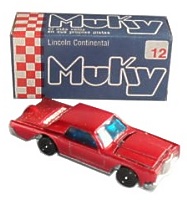
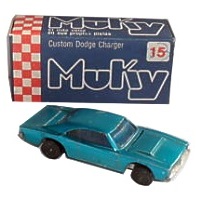

Contrarily to the later models, the earliest Muky models (first edition models) were painted in very glossy colours and had all-black wheels, and they were only rarely decorated with decals.
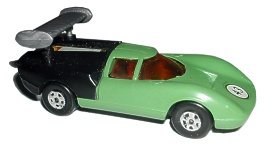
In the late 1970s, production was moved to Brazil due to the complicated economical situation Argentina was going through at that time.
A few years later, a Mr. Dell Arciprete bought the Muky range. The models were made in Gualeguay again, and the new owner kept on the original designs. However the baseplates, originally made of diecast metal, were altered: They were now made of plastic (as a result of this, the models ran faster) and bore the new company name: "Induguay". Several new models were added to the range until the end of the 1980s.
In the catalogue, as well as on the bottom side of the boxes in the "Induguay" era, 30 Muky models were listed:
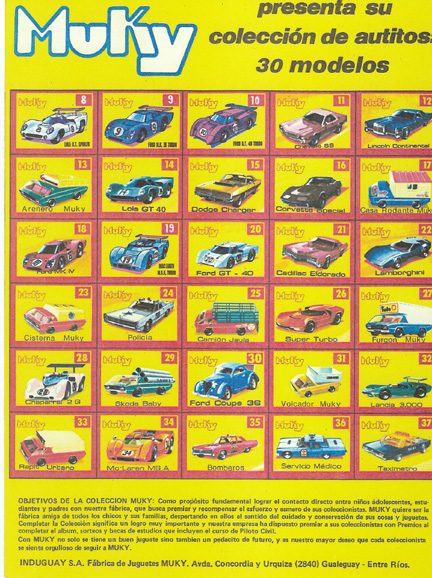
Source: http://www.breithaupts.com/totc415.htm
However, at least 33 different models have been released:
- Nr. 1-6: unknown
- Nr. 7: Ford Sedan 41
- Nr. 8: Lola GT Spoiler
- Nr. 9: Ford MK IV Turbo
(similar to Nr. 18, with spoiler) - Nr. 10: Ford GT 40 Turbo
(similar to Nr. 20, with spoiler) - Nr. 11: Chevelle SS
(based on Hot Wheels Custom AMX) - Nr. 12: Lincoln Continental
- Nr. 13: Arenero MUKY
(tipper based on Hot Wheels Deora) - Nr. 14: Lola GT 40
- Nr. 15: Dodge Charger
- Nr. 16: Corvette Special
- Nr. 17: Casa Rodante MUKY
(camper based on Hot Wheels Deora) - Nr. 18: Ford MK IV
- Nr. 19: Mac Laren MGA Turbo
(similar to Nr. 34, with spoiler) - Nr. 20: Ford GT 40
- Nr. 21: Cadillac Eldorado
- Nr. 22: Lamborghini Special
(based on Hot Wheels Torero) - Nr. 23: Cisterna MUKY
(tanker based on Hot Wheels Deora) - Nr. 24: Policia
(68 Plymouth Fury)
- Nr. 25: Camión Jaula
(stake bodied pickup based on
Hot Wheels Deora) - Nr. 26: Super Turbo
(based on Hot Wheels Turbofire) - Nr. 27: Furgón MUKY
(van bodied pickup based on
Hot Wheels Deora) - Nr. 28: Chaparral 2 G
- Nr. 29: Skoda Baby
(pipe loaded pickup based on
Hot Wheels Deora) - Nr. 30: Ford Coupe 36
- Nr. 31: Volcador MUKY
(dumper based on Hot Wheels Deora) - Nr. 32: Lancia 3000
(similar to Nr. 26, with spoiler) - Nr. 33: Rapit Urbano
(similar to Nr. 27) - Nr. 34: Mac Laren MGA
- Nr. 35: Bomberos
(similar to Nr. 24, fire chief car) - Nr. 36: Servicio Médico
(similar to Nr. 24, paramedic car) - Nr. 37: Taximetro
(similar to Nr. 24, taxi) - Nr. 38: Volkswagen
- Nr. 39: Ferrari 308
For instance, all truck models were based on the Hot Wheels Deora casting. On the left the Hot Wheels model, on the right the Muky model with a van body (Nr. 27, Furgón MUKY):
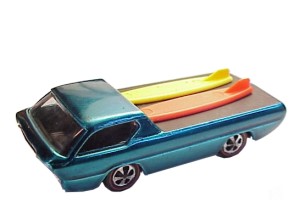
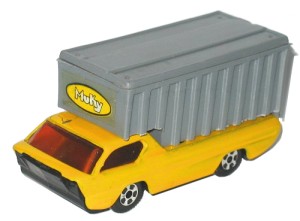
Other versions of the Deora include a tipper (Nr. 13) and another delivery van (Nr. 33):
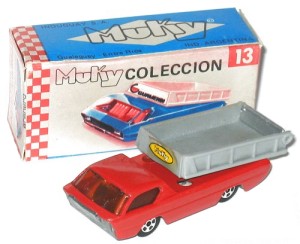
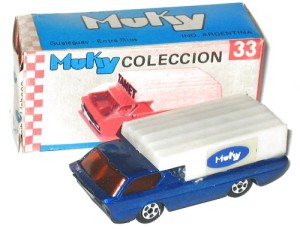
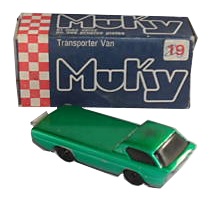
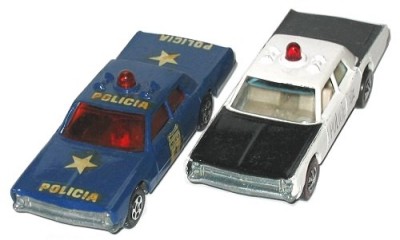
However, the origins of the Muky castings are not very clear. According to Bob Frassinetti from Buenos Aires Toy Museum, the first owners of the Muky brand did buy some castings in California where Mattel was based, but they didn't buy them directly from that company. At that time Mattel commissioned third parties with the development of new castings. It seems that such an independent casting craftsman sold Hotwheel-alike castings to the Argentinean company. As a result, Muky models shared the same original castings with Hot Wheels models, but the castings were neither bought from Mattel nor stolen. The new models released by Induguay in the 1980s, such as the Volkswagen Beetle and the Ferrari 308, were designed by the Argentinean company itself.
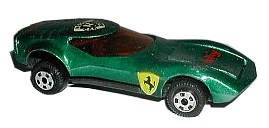
Muky models were also exported to other countries such as Uruguay and Spain. But Argentina remained the most important market for the company, and their products were quite popular there, even if they were cruder than the 1:64 scale models made by Buby, their most important competitor.
Sources and further reading:
- Bob Frassinetti: Made in Argentina: The Muky Story. In: Model Auto Review 186, October 2004, pp. 9348-9349.
- Bob Frassinetti: Muky, made in Argentina. Joe's Diecast Shack, 3rd August 2004. URL: http://www.joesdiecastshack.com/bobfrasmuky.htm.
- Bob Frassinetti: Muky diecast made in Argentina for sale. 18th April 2005. URL: http://muky-argentina.tripod.com.
- Dave Weber and Kimmo Sahakangas: Muky of Argentina. Tales of Toy Cars, August 2003. URL: http://www.breithaupts.com/totc415.htm.
- : Les clones et copies, customs et news. Les news des Mopar Miniatures No. 25, 24th October 2004. URL: http://www.mopar-owners-club.com/miniatures/actu/news25.html (pictures of Deora trucks and police cars).